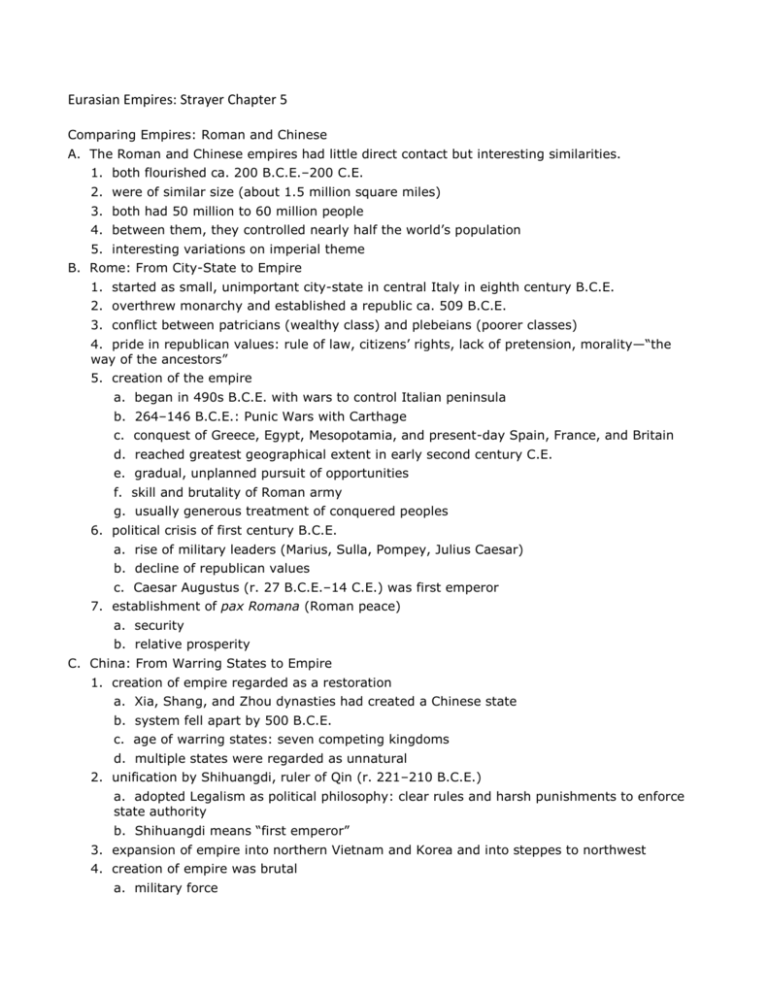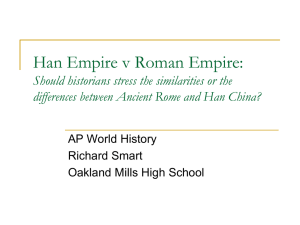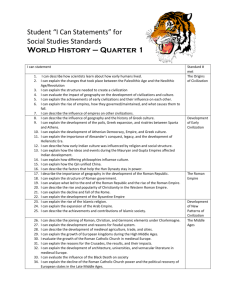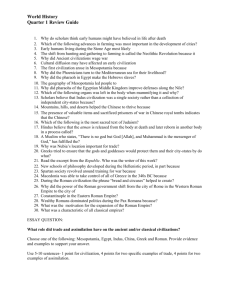Eurasian Empires: Strayer Chapter 5
advertisement

Eurasian Empires: Strayer Chapter 5 Comparing Empires: Roman and Chinese A. The Roman and Chinese empires had little direct contact but interesting similarities. 1. both flourished ca. 200 B.C.E.–200 C.E. 2. were of similar size (about 1.5 million square miles) 3. both had 50 million to 60 million people 4. between them, they controlled nearly half the world’s population 5. interesting variations on imperial theme B. Rome: From City-State to Empire 1. started as small, unimportant city-state in central Italy in eighth century B.C.E. 2. overthrew monarchy and established a republic ca. 509 B.C.E. 3. conflict between patricians (wealthy class) and plebeians (poorer classes) 4. pride in republican values: rule of law, citizens’ rights, lack of pretension, morality—―the way of the ancestors‖ 5. creation of the empire a. began in 490s B.C.E. with wars to control Italian peninsula b. 264–146 B.C.E.: Punic Wars with Carthage c. conquest of Greece, Egypt, Mesopotamia, and present-day Spain, France, and Britain d. reached greatest geographical extent in early second century C.E. e. gradual, unplanned pursuit of opportunities f. skill and brutality of Roman army g. usually generous treatment of conquered peoples 6. political crisis of first century B.C.E. a. rise of military leaders (Marius, Sulla, Pompey, Julius Caesar) b. decline of republican values c. Caesar Augustus (r. 27 B.C.E.–14 C.E.) was first emperor 7. establishment of pax Romana (Roman peace) a. security b. relative prosperity C. China: From Warring States to Empire 1. creation of empire regarded as a restoration a. Xia, Shang, and Zhou dynasties had created a Chinese state b. system fell apart by 500 B.C.E. c. age of warring states: seven competing kingdoms d. multiple states were regarded as unnatural 2. unification by Shihuangdi, ruler of Qin (r. 221–210 B.C.E.) a. adopted Legalism as political philosophy: clear rules and harsh punishments to enforce state authority b. Shihuangdi means ―first emperor‖ 3. expansion of empire into northern Vietnam and Korea and into steppes to northwest 4. creation of empire was brutal a. military force b. execution of scholars, book burning c. hundreds of thousands of laborers built Great Wall d. Shihuangdi’s monumental tomb, with about 7,500 life-size ceramic statues e. standardized weights, measures, currency, written Chinese, and even axle lengths for carts 5. Qin dynasty collapsed in 206 B.C.E.; followed by Han dynasty (206 B.C.E.–220 C.E.) a. kept Qin centralization b. less harsh D. Consolidating the Roman and Chinese Empires 1. both empires defined themselves in universal terms 2. both invested heavily in public works 3. both claimed supernatural sanctions a. deceased Roman emperors as gods b. Chinese emperor as Son of Heaven 4. both absorbed a foreign religious tradition a. development of Christianity in Roman Empire b. introduction of Buddhism into China by traders 5. relationships with societies they governed a. Romans were always a minority in empire b. ethnic Chinese had much larger cultural heartland 6. role of language differed in the two empires a. Latin (alphabetic language) gave rise to Spanish, Portuguese, French, Italian, Romanian b. Chinese characters (which represented words or ideas) could not be transferred easily to other languages 7. Roman Empire’s peoples maintained separate cultural identities far more than in China 8. Bureaucracy was much more elaborate in China than in Roman Empire a. Chinese emperor Wudi (r. 141–87 B.C.E.) established an academy to train officials based on works of Confucius b. Roman administration relied on regional elites and army E. The Collapse of Empires 1. Why do they fall? a. Han dynasty ended in 220 C.E. b. traditional date for fall of western Roman Empire is 476 C.E.; eastern half survived as Byzantine Empire 2. common factors a. excessive size, overextension, too expensive for available resources b. no great technological breakthrough to enlarge resources c. tax evasion by large landowning families d. tax burden fell heavily onto the poor e. rivalry between elite factions created instability f. epidemic disease g. threat from nomadic or semi-agricultural peoples on frontier: China dealt with Xiongnu; Roman Empire, with Germanic-speaking peoples 3. effects of imperial collapse a. decline of urban life b. population decline c. reduction of international trade d. vast insecurity 4. most important difference between collapse of Han and Roman empires: what happened next a. China: about 350 years of disorder, then creation of a similar imperial state (Sui, Tang, and Song dynasties) b. Europe: no large-scale imperial system has ever been successfully established in Western Europe since Romans c. Why was China more successful in restoration? Intermittent Empire: The Case of India A. The idea of empire was much less prominent in India than in Persia, the Mediterranean, or China. 1. fall of Indus Valley civilization by 1500 B.C.E. 2. creation of new civilization along Ganges River 3. establishment in northern India of classic civilization of South Asia by 600 B.C.E. a. enormous political, ethnic, cultural, and linguistic diversity b. Indian civilization as a whole shaped by political fragmentation and cultural diversity c. identity provided by distinctive religious tradition (Hinduism) and social organization (caste system) B. Mauryan Empire (326–184 B.C.E.) 1. stimulated by Persian and Greek penetration of northwest 2. ruled all but southern tip of India 3. population of around 50 million 4. large military and civilian bureaucracy 5. state-operated industries 6. Ashoka (r. 268–232 B.C.E.) is best-known emperor, thanks to edicts 7. Mauryan Empire broke apart after Ashoka’s death C. Gupta Empire (320–550 C.E.) and other short-lived empires followed D. Why couldn’t India maintain an empire? 1. states failed to command loyalty 2. great cultural diversity 3. frequent invasions from Central Asia 4. caste system encouraged local loyalties E. Indian trade flourished despite the lack of unity. 1. merchants and artisans patronized public buildings and festivals 2. Hinduism and Buddhism spread through much of Asia 3. Indian mathematics and astronomy flourished







